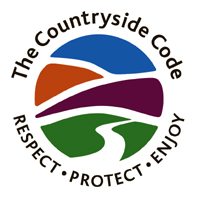People often ask what they can or cannot do when walking. This section gives you some basic information. It is not by any means exhaustive or legally binding. If a legal question is involved you are urged to seek the services of the KCC Rights Of Way Officer concerned, or legally qualified professionals. A brief description of the different types of public rights of way is as follows: – A footpath (FP) where the public have a right of way on foot. A bridle way (BR) where the public may walk, ride or lead a horse, or ride a pedal cycle. A byway may be open to all traffic (BOAT), or a restricted byway (RBW) on which mechanically propelled vehicles are prohibited.
Most of these ways are unsurfaced tracks but they are highways, normally maintained by the Highway Authority (HA) e.g. Kent County Council. The HA has a general duty under the Highways Act 1980, “to assert and protect the rights of the public to the use and enjoyment” of public paths in their area and to “prevent as far as possible the stopping-up and obstruction” of those paths. The HA also has a general duty to sign public rights of way where they join a metalled road and it is an offence to damage or deface such signs. The HA may also way mark paths to assist users but private individuals may not erect signs or way marks without authority. Recommended colour coding signs are – yellow for FPs, blue for BRs, red for BOATS and purple for RBWs. National long-distance routes have individual logos, for example – an acorn for the North Downs Way; WW for the Wealdway; and a red helmet for the Saxon Shore Way. Incidentally, all those three routes pass through Gravesham.
There is no general statutory definition of a minimum or maximum width for a public right of way. However, a width may be recorded in the Definitive Statement, in a legal Order, or the Right of Way (ROW) may have a customary width. Statutory provisions only apply in respect of paths which have been disturbed or ploughed. Landowners are responsible for removing overgrowth and growing crops, for maintaining stiles and gates in good repair, with a grant from the HA and for reinstating paths after ploughing. It is, however, illegal to plough a byway or headland FP or BR. Other FPs and BRs may be ploughed but reinstatement must be carried out within 14 days so that the surface is reasonably convenient for users. The line of the footpath must be visible on the surface to the minimum widths of 1 metre and 2 metres for cross field paths FPs and BRs respectively. Headland FPs and BRs must be left unploughed to minimum widths of 1.5 metres and 3 metres respectively. Other than grass or grass mixture, no crops may be grown on the surface as to inconvenience users or fall over the path to reduce the widths beyond those quoted above.
Mention should also be made of Countryside Access Land where there is a “right to roam” These areas are subject to restrictions and exclusions not applicable to public rights of way. For example, they may be subject to temporary closure, restrictions or a ban on walking with your dog. Attention must be paid to on-site notices. Ordnance Survey maps show public rights of way. The Landranger, Pathfinder and Explorer series all cover the areas in which the Group walks. However these maps may not be up to date. If necessary the best check is to refer to the second Definitive Map of Public Rights of Way, which was prepared under a 1949 Act of Parliament and was produced in 1987 in Kent. Copies can be inspected at County and Borough Council offices, by application to Clerks of Parish Councils and principle public libraries. Changes are more likely to be entered on County and Borough Council copies. The Group can also usually advise about changes in the Gravesham Borough Council area Explore Kent’s Interactive Map offers information on the county’s public rights of way, country parks and open spaces, natural habitats and promoted routes across Kent.
Finally, please remember to always follow the Countryside Code.
- Respect other people
- Consider the local community and other people enjoying the outdoors
- Leave gates and property as you find them and follow paths unless wider access is available
- Protect the natural environment
- Leave no trace of your visit and take your litter home
- Keep dogs under effective control
- Enjoy the outdoors
- Plan ahead and be prepared
- Follow advice and local signs
For lots more information on using the country side visit the Natural England web site.
